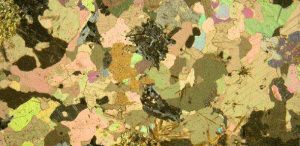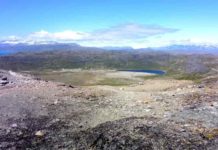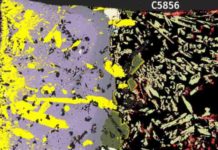
Vital to many modern technologies yet mined in few places, the ‘rare earth elements’ are in fact not that rare – they are just difficult to find in concentrations that make them economic to mine. Researchers from Cambridge University and the British Antarctic Survey (BAS) are investigating whether the remarkable properties of these materials can be used to track them down from the air.
Next time you use your mobile phone, spare a moment for the tiny yet vital ingredients that make this and many other technologies possible – the rare earth elements (REEs).
Used in computers, fibre optic cables, aircraft components and even the anti-counterfeiting system in euro notes, these materials are crucial for an estimated £3 trillion worth of industries, with demand set to increase over the coming decades.
Currently, more than 95% of the global demand for the REEs is met by a single mine in China. The security of the future supply of these 17 critical metals, which include neodymium, europium, terbium, dysprosium and yttrium, is a major concern for European governments, and the identification of potential REE resources outside China is seen as a high priority.
Over the past year, Drs Sally Gibson, Teal Riley and David Neave have been working together through a University of Cambridge–BAS Joint Innovation Project (see panel) on a remote sensing technique that could aid the identification of REEs in rocks anywhere in the world. The project brings together expertise in remote sensing, geochemistry and mineralogy from both institutes to take advantage of the properties that make the metals so special.
“Despite their name, the rare earth elements are not particularly rare and are as abundant in the Earth’s crust as elements such as copper and tin,” explains Riley from BAS. “However, to be extractable in an economic way, they need to be concentrated into veins or sediments.” It’s the identification of these concentrations that is critical for the future security of supply. REEs all have an atomic structure that causes them to react to photons of light through a series of electronic transitions. This gives them the magnetic and electrical properties for which they are prized in plasma TVs, wind turbines and electric car batteries. And it also means that for every photon of light they absorb, they reflect other photons in a unique way – it is this property that the researchers have latched onto as a means of tracking them down.
“The light they reflect is so specific that it’s like a fingerprint, one that we can capture using sensors that pick up light emissions,” explains Gibson, from Cambridge’s Department of Earth Sciences. “The difficulty, however, is that in naturally occurring rocks and minerals, the rare earth element emission spectra are mixed up with those of other elements. It’s like looking at overlapping fingerprints – the challenge was to work out how to tease these spectral fingerprints apart.”
Gibson has over 20 years’ experience investigating how REEs are generated during the melting of the Earth’s mantle. “Collective understanding of the geological make-up of the world is now good enough that we know where to look for these rocks – at sites of a certain type of past tectonic activity – but even then it’s difficult to find them.”
Riley is the head of the Geological Mapping Group at BAS – his job is to “map the unmapped” areas of the polar region to understand the geological evolution of the continent. Much of his work depends on being able to develop new ways of interrogating satellite- and aircraft-based remote sensing data. “It became a frustration that we could collect data and say generally what was on the ground but that we couldn’t define individual fingerprints, and so we developed the analytical tools to do this.”
Gibson and Neave gathered rocks containing REE-bearing minerals from around the world – sourced from mining companies, museum collections and universities. One such source was the Harker Collection housed in the University’s Sedgwick Museum of Earth Sciences. This collection contains specimens of minerals and rocks rich in REEs that were collected decades previously by geologists who were unaware of their economic importance.
Neave analysed the emission spectrum of each rock and related this to its gross and microscopic composition. From this information he began to untangle the individual fingerprints, resulting in what the researchers believe is the most comprehensive ‘spectral database’ of REEs in their natural state – in rocks.
The next goal is to use this spectral database as a reference source to track down deposits from the air. “Although data from aircraft is now good enough to be analysed in this way, we are waiting for new satellite missions such as the German Environmental Mapping and Analysis Program (EnMAP) to be launched in the next few years,” explains Riley.The plan would then be to carry out reconnaissance sweeps of the most likely terrains and explore the possibility of mining these areas. “Our hope is that this research will help to create an internationally unique and competitive capability to map these surprisingly common – yet difficult to find – materials,” adds Gibson.
Aurora Cambridge
The search for rare earth elements is one of a host of ongoing projects between the University and BAS. Like these, a new centre – Aurora Cambridge – will reflect the ethos that innovation developed for the Antarctic is transferable to a global setting.
Aurora Cambridge aims to generate new research and entrepreneurial activity focused on climate change and challenging environments through academic, business and policy partnerships. It will be located at BAS in Cambridge and has been funded by the National Environment Research Council with support from the University.
The building is due to open in 2017; however, 27 University of Cambridge–BAS Joint Innovation Projects are already under way with funding from the Higher Education Funding Council for England – including the development of mapping technologies for rare earth elements led by Drs Sally Gibson and Teal Riley.
Other projects include research on cold-adapted enzymes with potential applications in the biotech industries, remote sensing for conservation of seabirds and marine mammals, and the measurement of coastal vulnerability through sea-level rise. Many involve external industrial partners and other research institutions as well as researchers from BAS and 12 University departments.
“The collaborative projects demonstrate not only the importance of research technology to the Antarctic but also their transferability beyond its shores to a global setting,” explains BAS Director of Innovation Dr Beatrix Schlarb-Ridley. “The SPECTRO-ICE project, for instance, has brought scientists at BAS who are concerned with monitoring the atmosphere above the ice cap together with physicists and mathematicians who are working hard to avoid seeing the atmosphere in their study of the stars – both use similar techniques and need to operate advanced instruments at difficult locations.”
“This is just the beginning,” says BAS Director Professor Jane Francis. “The new innovation centre will help us to extend the range of fruitful partnerships with academia, business, policy makers and the third sector to create tangible benefits for society.”
Note: The above post is reprinted from materials provided by University of Cambridge.










